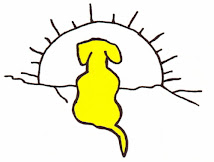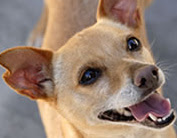What was the issue? We had a cookie malfunction: my darling husband was carrying a cookie and half of it fell out of his hand and flew across the slippery hardwood floor like a hockey puck on the way to the goal. Needless to say, Poncho McQuikie pants was right on its tail!
I was in the other room, watching the whole thing go down, envisioning Poncho consume his entire caloric intake for the week in one bite, but before his soft warm fuzzy lips wrapped themselves around the delectable molasses chew from Trader Joes, I yelled out "Leave it!" as I was flying out of the chair and across the room, while reaching in and grabbing the mouthwatering morsel up off the floor...AND BY GOLLY PONCHO THE DOG DID IT! Poncho actually backed away from it even BEFORE my hand was near it! I was so shocked I did the happy dance, said he was a good boy, then broke off a tiny, Poncho-sized piece for his reward of leaving it alone!
The "Leave it!" behavior is one of the basic cues I teach in many of my dog training classes here in Ventura. And I guess all the practice with him as my demo dog has paid off! During this more emotional time, I allowed all the training practice to kick in and lo and behold it worked! One of my dog training class mantra's is "Train it before you need it!" or "Don't wait to need a behavior to train a behavior!" I always hope I never have to use this type of cue (usually indicates danger), but it's nice to know I have it in my arsenal just in case there is a cookie incident.
Another point I make in my dog training classes is the concept of "trust". The use of food in dog training helps dogs develop trust between themselves and whomever is working with them, or with other humans. For owners, they need to trust that their dogs are actually going to perform the behaviors they are being taught. I guess I'm the prime example of that!
Thank you my darling inquisitive canine Poncho! I hope I won't need to use that cue again, but it's nice to know you're paying attention and that I can trust you know you're stuff - and the cues! What a good boy you are!



